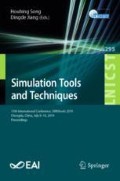Abstract
Neural network models have played an important role in text applications, such as document summaries and automatic short answer questions. In previous existing works, questions and answers are together used as input in recurrent neural networks (RNN) and convolutional neural networks (CNN), then output corresponding scores. This paper presents a method for measuring the score for short answer questions and answers. This paper makes scoring by establishing a hierarchical word-sentence model to represent questions and answers and using the attention mechanism to automatically determine the relative weight of questions and answers. Firstly, the model combines CNN and Bidirectional Long Short-Term Memory Networks (BLSTM) to extract the semantic features of questions and answers. Secondly, it captures the representation vector of relevant questions and answers from the sentence-level features. Finally, all feature vectors are concatenated and input to the output layer to obtain the corresponding score. Experiment results show that the model in this paper is better than multiple baselines.
Access this chapter
Tax calculation will be finalised at checkout
Purchases are for personal use only
References
Alikaniotis, D., Yannakoudakis, H., Rei, M.: Automatic text scoring using neural networks, pp. 715–725 (2016)
Attali, Y., Burstein, J.: Automated essay scoring with e-rater®; vol 2.0. J. Technol. Learn. Assess. 4(2), i–21 (2006)
Bahdanau, D., Cho, K., Bengio, Y.: Neural machine translation by jointly learning to align and translate. Comput. Sci. (2014)
Chen, Y.Y., Liu, C.L., Chang, T.H., Lee, C.H.: An unsupervised automated essay scoring system. IEEE Intell. Syst. 25(5), 61–67 (2010)
Chorowski, J., Bahdanau, D., Serdyuk, D., Cho, K., Bengio, Y.: Attention-based models for speech recognition. Comput. Sci. 10(4), 429–439 (2015)
Dong, F., Zhang, Y.: Automatic features for essay scoring - an empirical study. In: Conference on Empirical Methods in Natural Language Processing (2016)
Farra, N., Somasundaran, S., Burstein, J.: Scoring persuasive essays using opinions and their targets. In: NAACL 2015 Workshop on Innovative Use of NLP for Building Educational Applications (2015)
Graves, A.: Generating sequences with recurrent neural networks. Comput. Sci. (2013)
Graves, A., Mohamed, A.R., Hinton, G.: Speech recognition with deep recurrent neural networks 38(2003), 6645–6649 (2013)
Johnson, R., Zhang, T.: Effective use of word order for text categorization with convolutional neural networks. Eprint Arxiv (2014)
Klebanov, B.B., Flor, M.: Word association profiles and their use for automated scoring of essays. In: Proceedings of Annual Meeting of the Association for Computational Linguistics ACL, pp. 1148–1158 (2013)
Mcnamara, D.S., Crossley, S.A., Roscoe, R.D., Allen, L.K., Dai, J.: A hierarchical classification approach to automated essay scoring. Assessing Writ. 23, 35–59 (2015)
Project Essay Grade: Project essay grade, peg (2003)
Pang, L., Lan, Y., Guo, J., Xu, J., Wan, S., Cheng, X.: Text matching as image recognition (2016)
Somasundaran, S., Burstein, J., Chodorow, M.: Lexical chaining for measuring discourse coherence quality in test-taker essays, Martin (2014)
Sutskever, I., Vinyals, O., Le, Q.V.: Sequence to sequence learning with neural networks 4, 3104–3112 (2014)
Taghipour, K., Ng, H.T.: A neural approach to automated essay scoring. In: Conference on Empirical Methods in Natural Language Processing (2016)
Yang, Z., Yang, D., Dyer, C., He, X., Smola, A., Hovy, E.: Hierarchical attention networks for document classification. In: Conference of the North American Chapter of the Association for Computational Linguistics: Human Language Technologies, pp. 1480–1489 (2017)
Zhou, X., Wan, X., Xiao, J.: Attention-based LSTM network for cross-lingual sentiment classification. In: Conference on Empirical Methods in Natural Language Processing, pp. 247–256 (2016)
Zhou, Y., Li, C., Xu, B., Xu, J., Cao, J.: Hierarchical Hybrid Attention Networks for Chinese Conversation Topic Classification (2017)
Zhou, Y., Xu, J., Cao, J., Xu, B., Li, C.: Hybrid attention networks for chinese short text classication. Computacion Y Sistemas 21(4), 759–769 (2017)
Author information
Authors and Affiliations
Corresponding author
Editor information
Editors and Affiliations
Rights and permissions
Copyright information
© 2019 ICST Institute for Computer Sciences, Social Informatics and Telecommunications Engineering
About this paper
Cite this paper
Qi, H., Wang, Y., Dai, J., Li, J., Di, X. (2019). Attention-Based Hybrid Model for Automatic Short Answer Scoring. In: Song, H., Jiang, D. (eds) Simulation Tools and Techniques. SIMUtools 2019. Lecture Notes of the Institute for Computer Sciences, Social Informatics and Telecommunications Engineering, vol 295. Springer, Cham. https://doi.org/10.1007/978-3-030-32216-8_37
Download citation
DOI: https://doi.org/10.1007/978-3-030-32216-8_37
Published:
Publisher Name: Springer, Cham
Print ISBN: 978-3-030-32215-1
Online ISBN: 978-3-030-32216-8
eBook Packages: Computer ScienceComputer Science (R0)

